Inside the Mind of Tough Mudder’s CEO and His Plan for Transformation—and Domination
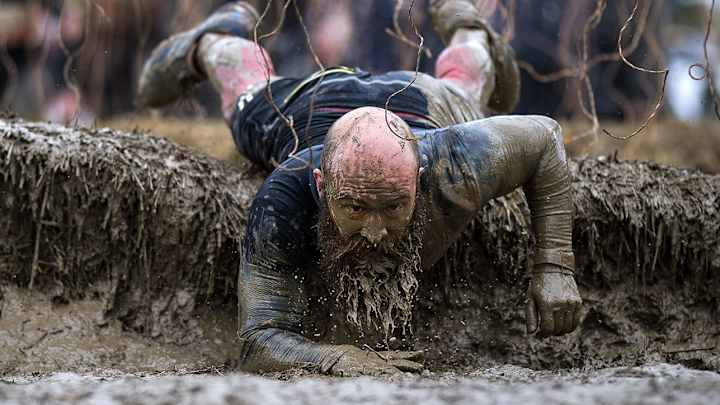
Tough Mudder CEO Will Dean knows he lacks excitement when speaking publicly, but he’ll still lead a chant echoed by millions worldwide at a business presentation. Every Tough Mudder event—whether it’s a five-mile Tough Mudder Half or the 24-hour excursion to be a World’s Toughest Mudder—commences with a resident MC shouting “tough!” and the participants responding “mudder!” Whether it’s a burly, mohawked man bellowing as he feels 1,000 volts jolt his testicles or a woman screeching after plunging into the 34-degree water of the “Arctic Enema,” Tough Mudder wants you to yell. Otherwise, how will you be motivated to dive into an ice bath covered in mud?
Clad in a cardinal red company polo, the 37-year-old Dean starts his presentation in to prospective investors with the Tough Mudder chant and the goal of luring somebody to front him money for a new venture: Tough Mudder Bootcamp. The seventh floor of their Brooklyn offices is hosting the standard Power Point presentation to generate excitement. The eighth floor is the test site for how Tough Mudder wants to transform between now and 2021. The general theme of it all? YOUR GYM SUCKS.
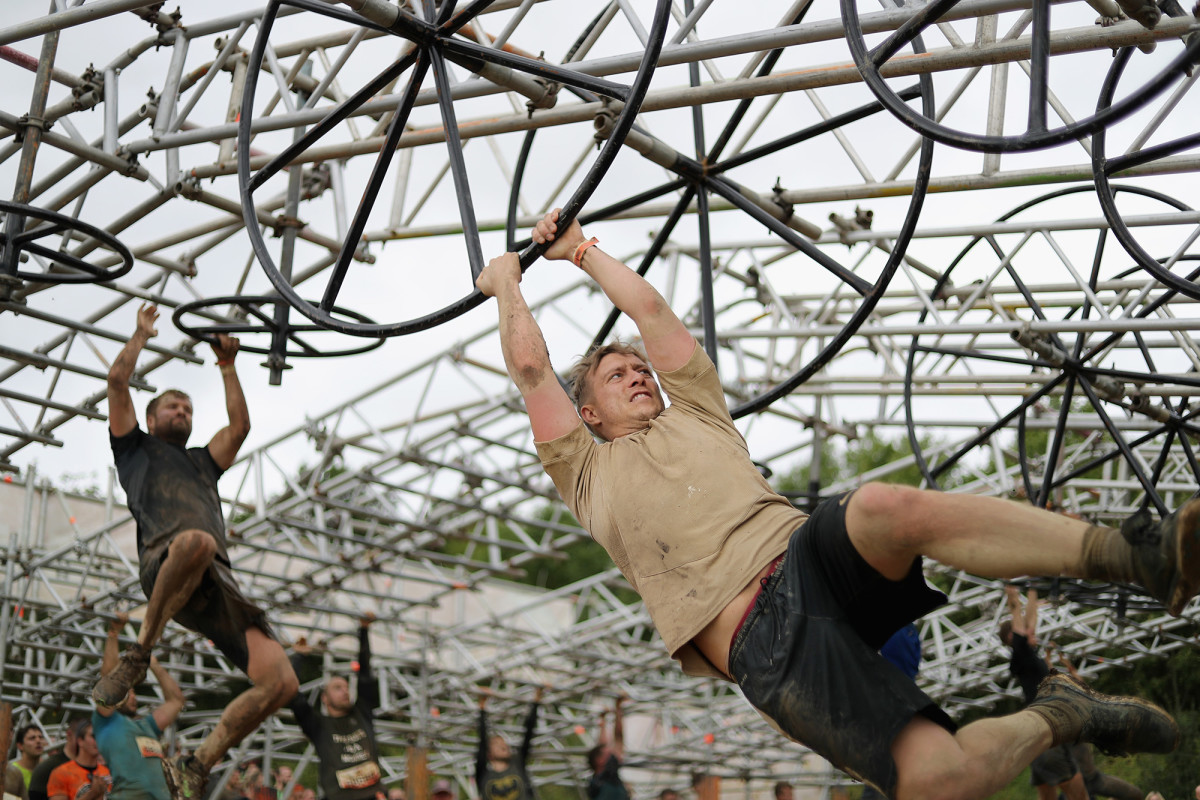
“My goal is for Tough Mudder to be as recognizable as Harley Davidson,” Dean says. “Harley knew there were faster motorcycles, but they knew they could create community with their logo. People wanted those leather jackets and, in turn, wanted the motorcycles. We think people want to be Tough Mudders once they get exposed.”
Now in his ninth year running Tough Mudder, Dean’s corporate tale is legend among business schools and their quarterly reviews. A former employee of British counter-terrorism who derided marathons and triathlons as “pointless” and “antisocial,” Dean discovered few alternatives for endurance events that tested physical and mental stamina to their logical extremes. Mud runs and obstacle courses existed as recreational attractions; what Dean sought was punishment.
The event closest to his vision was England’s “Tough Guy Challenge”—which featured obstacles like the “Death Plunge” and “Torture Chamber”—founded by former British Army officer Billy Wilson. Confident a similar extreme obstacle course would thrive in the U.S., Dean teamed up with childhood friend Guy Livingstone and invested $20,000 to create Tough Mudder in 2009. The first edition of the event was designed to accommodate 500 people. But after a relentless marketing campaign and $8,000 worth of Facebook ads, 4,500 signed up to come to Bear Creek Ski Resort in Allentown, Pa.
While viewing one of Dean’s presentations, you could confuse his demeanor for bashfulness. Then you consider the company he created and, in the greater fitness community, why he is often compared to Mark Zuckerberg. Wilson sued him citing “immoral and despicable conduct” and called him “the worst, most wicked person that you could ever turn out of Harvard.” (They settled out of court for $750,000.) Joe DeSena, the founder of the competing Spartan Race, who is also debuting its own boutique fitness series, said “there’s not a person on this planet I despise more than Will Dean … every day I wake up just out of spite for the guy,” in an Outside 2012 cover story.
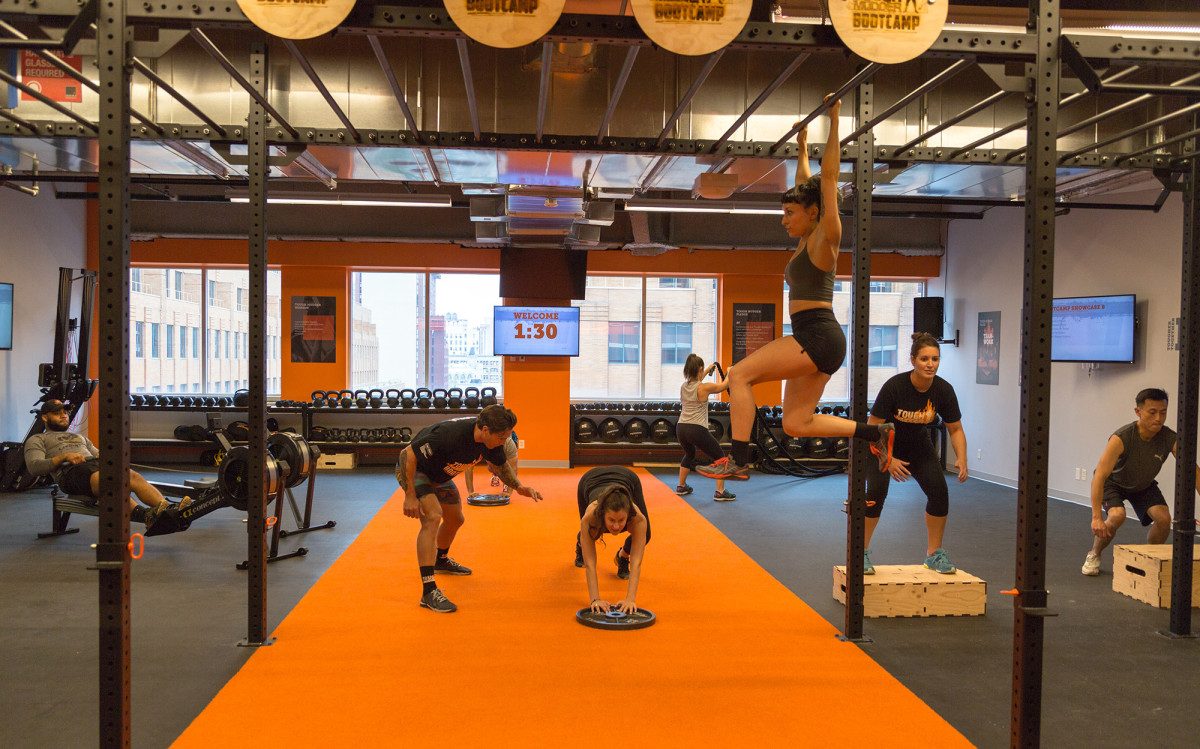
So will obstacle race’s enfant terrible be able to invade American exercise's latest trend? Or is the studio marketed already saturated? Dean’s success hinged on an understanding that a filthy and arduous run through wilderness eschewed life’s inevitable monotony. Now, he’s confident he can reshape what Tough Mudder initially disrupted: the dreariness of Tuesday exercise, but there are no mud baths nor human pyramids in a suburban studio.
“Not all people,” Dean says with some slyness, “are meant to be entrepreneurs.”
Unwilling to remain solely in the obstacle fitness realm, Dean flips to a Power Point slide showcasing his admirable social media following—4.2 million Facebook likes for starters—as evidence that his studio experience already boasts a better chance at success than any of his competitors. He’s already secured one investor to open a gym outside of Boston by the end of the year, and his aggressive expansion plan targets 1,000-1,200 units by 2021 with the target of a $10-$15 fee per class. Young urbanites are driving the continued rise of boutique entities like SoulCycle, Orange Theory Fitness and Pure Barre, but most Americans associate workouts with “big box” gyms, large brick-and-mortar institutions filled with heavy equipment, rows of televisions and individualized workouts. When visiting a local gym in his wife’s home of Ann Arbor, Mich., Dean surveyed customers on their standard gym visit, which he claims averaged a “two or three out of ten” experience of satisfaction. When asked why patrons even attended if the experience was so negative, the common refrain was “imagine how much worse it would be if I didn’t go.”
The most visible disruption (“a word that is used far too often in our entrepreneurial space,” says Dean) remains SoulCycle, the aforementioned New York-based fitness company that altered the common spin class into a course that combines stationary cycling and upper-body workouts. The added perks—aromatherapy candles, expert instructors and a sense of community—helped bolster its incredible retention rate and form a quasi-religious following (one so vociferous that it earned a direct spoof in The Unbreakable Kimmy Schmidt and a veiled one in The New York Times).
“We found that a lot of the dedication in SoulCycle came from the quality of the instructor,” Dean says. “We want the best instructors, but too often the coach is the star of those workouts. We want the workout to be the star.”
Dean hired vice president of new business development Cathrin Bowtell and trainer Eric “ERock” Botsford to design a group exercise class that integrated the company’s credo of unselfishness with a rigorous workout that is befitting of the Tough Mudder label. Bowtell arrived from FlyWheel, an indoor cycling company similar to SoulCycle, while Botsford, a former professional wakeboarder and fitness extraordinaire, was recruited by Dean after he participated in numerous Tough Mudders and Ultimate Tough Mudder. All of them worked incognito for around a year testing class and cultivating the ideal workout to meet each of their pillars: strength, power, agility and endurance.
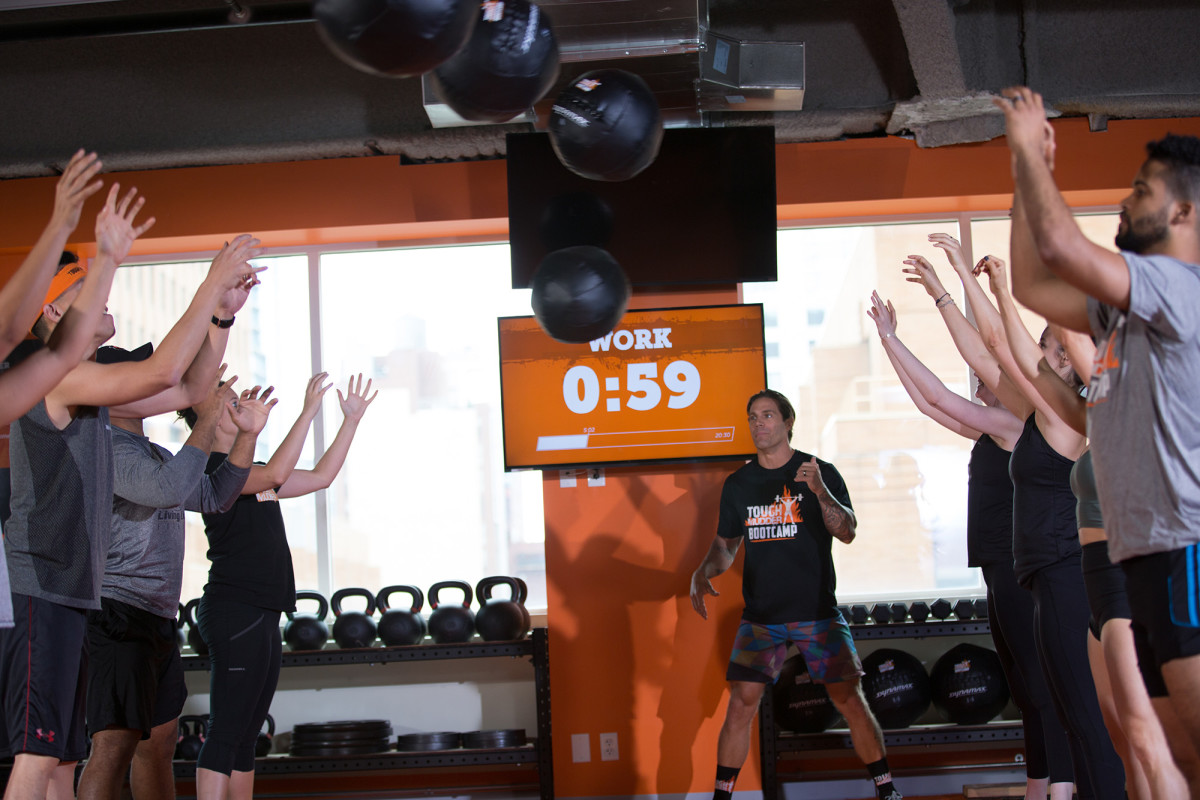
Their internal research revealed that the average person spends about $600 preparing for a Tough Mudder after their $100-$120 entry fee. Dean and his team figured if they created a centralized space for their voracious consumer base (they claim three million people have participated) and a recognizable brand, they could launch to the top of the studio space within five years.
The goal is to transform a modest 2000-foot test space into the idealized 45-minute workout that would draw in an everyday suburban customer. The investors present for the sample workout were treated to a tidy room on the office’s eighth floor emblazoned with fiery orange and TOUGH MUDDER block-lettering covering the walls and floor mats. The room featured six stations to be completed twice at two minutes apiece before a 30-second rest period. Everything from the opening stretch is completed in pairs: you select a partner, high-five them when you’re doing matching sit-ups and pump them up when they struggle through an exercise's final seconds whether they’re hurling a medicine ball toward a Tough Mudder-branded target or completing a 150-second plank. TV screens with precise primers on how to properly complete the exercise rest above each station.
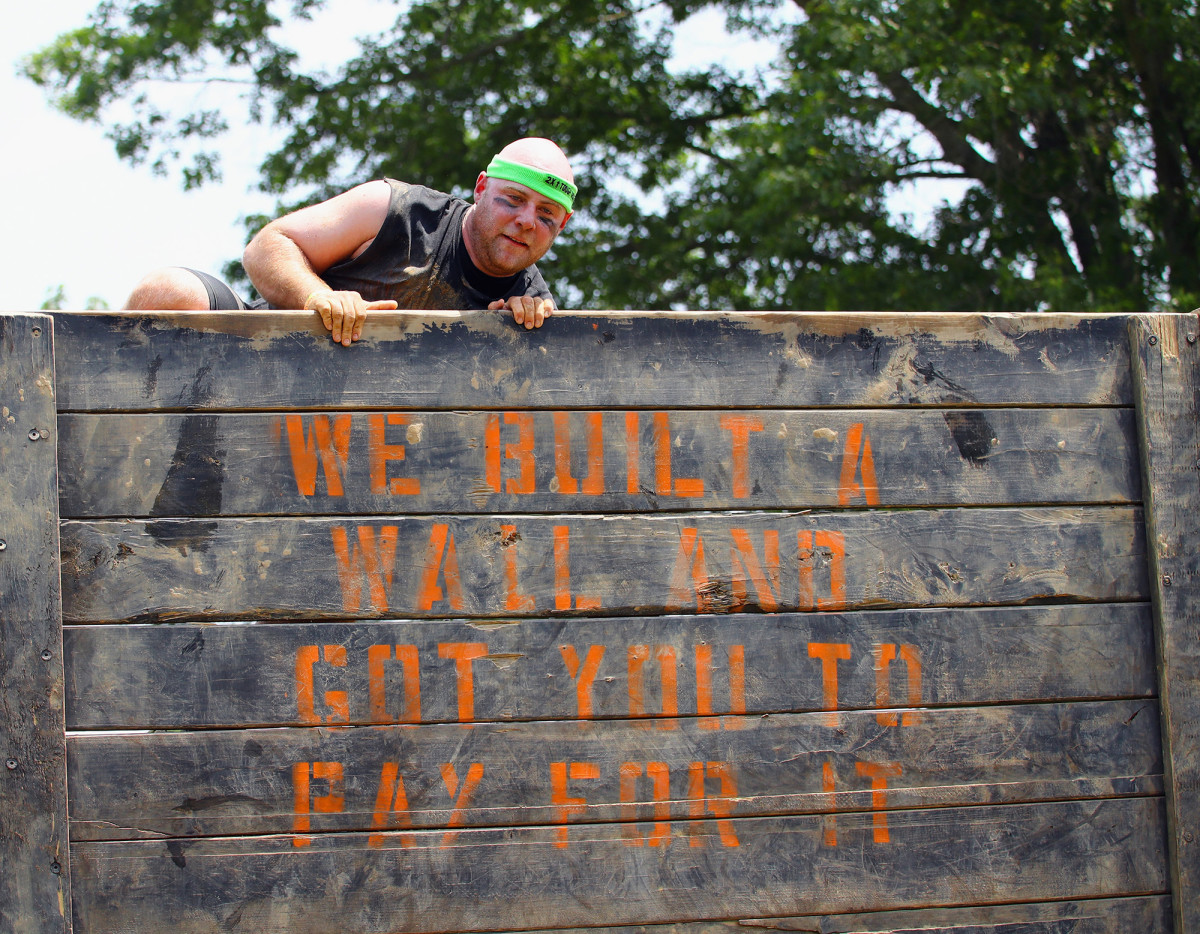
“We found that women do the exercise correctly pretty much as soon as they are instructed,” Dean says. “Men nod their head and say they know what to do before asking how to do it a few seconds later. That’s why we installed the TVs.”
The workouts don’t feature the metabolic equipment common in big box gyms and instead favor what Dean calls “functional equipment” that is quickly interchangeable among a big group. The six stations have the same set of workout equipment, but the course is designed to assure that a customer never repeats an identical workout. With instructors like Botsford—he of the chiseled pecs, full tattoo sleeve and bouncy demeanor of a Jack Russell Terrier—the participants are summoned to a serious, exhausting workout. Not even halfway through the 45-minute workout, even the more timid participants are high-fiving their peers and barking encouragement to people they just met. The cultish feel of Tough Mudder may be repellent to some, but it’s infectious, even with limited exposure.
Dean is fond of spouting statistics that vindicate his philosophy of team-oriented exercise: that working out as a group makes one seven times more likely to achieve their fitness and that no-shows at Tough Mudders are disproportionately individuals who signed up alone and not with a group. He’s even more fond of espousing what he deems Tough Mudder’s most essential virtue: that everybody is the same when they’re in the mud. “Did you know that Australian club rugby participation has declined by 15% in this generation?” Dean asks. “Union representation has gone down in this generation, so has most community-based activity. Our experience with Tough Mudders prove that people want community.” His philosophy echoes Robert Putnam’s theory of declining American social capital in the 2000 book Bowling Alone, that once in-person social interaction declined (Putnam famously cited bowling leagues as an example), American civic engagement and social capital decayed. The cross-application of Putnam to exercise is an intriguing one: the people participating in this workout are engaged despite the blaring dubstep and arduous exercises. They may be pained, but they look happy even before they can rest.
The standard Tough Mudder participant skewed heavily male until the debut of the “Tough Mudder Half,” which increased female participation. By entering the studio space, which remains predominantly female, Dean sees an opportunity to balance the gender dynamics of his consumer base and expand it. The goal is the kind of mass participation you can find at a spin class, but he also insists that the disruption isn’t complete; when he thinks of contemporary studio fitness, he thinks of dense urban centers. The kind of customer Dean seeks to create a base of suburban customers is one like Pam McFarland, one of Dean’s favorite Tough Mudder archetypes.
Best shoes for obstacle races, mud runs, Spartan Races, Tough Mudders and more
A 21-year-old from Warwick, R.I., McFarland suffers from chronic knee pain and, as she describes it, a crippling lack of self-confidence. After completing a local obstacle course, an acquaintance encouraged McFarland to sign up for a Tough Mudder. Transitioning from the equivalent of a fun run to a course, as Tough Mudder proudly advertises, “designed by British Special Forces” was ambitious for an admittedly overweight individual with severe knee issues.
Part of Dean’s selling point to the investors centered around the sense of accomplishment that accompanies completing one of their races—the orange head band, the Tough Mudder t-shirt, the feeling of withstanding electric voltage—offer participants newfound courage. Dean even relayed a tale of how one once-feeble individual bullied by a rapacious boss arrived at work with his Tough Mudder headband and confronted the boss by barking, “You can’t talk to me like that! I’m a Tough Mudder!” Some of the audience chuckled, others looked quizzically at Dean, but the point resonated even if the tale was apocryphal: once individuals identify with Tough Mudder, they’re hooked because of how it affects their self-esteem.
McFarland says that she has lost 60 pounds (“I feel like a badass, not a fatass”) since she started frequenting the Tough Mudder circuit. Her Facebook photo is of her sipping the contest’s congratulatory beer in front of a sign that reads I EARNED MY HEADBAND in block letters. After completing her second race, she entered her local tattoo parlor to get the Tough Mudder logo tattooed on her leg: one of Dean’s favorite boasts is that they know of some 20,000 people who have gotten inked with the Tough Mudder logo.
“I have five tattoos and it’s my favorite one,” McFarland says. “Every time I look at it, it feels amazing.” Find another brand, Dean challenges the audience, that inspires that many people to get a corporate logo branded onto their skin.
What Is Heart Rate Variability–and Do You Need to Know Yours?
The challenge is to expand beyond a customer McFarland, whom he can expect to consider signing up for a boot camp course, into high-end, potentially bored suburbanites seeking that quasi-religious experience. Academic research indicates that upper-class and upper-middle class people love endurance sports; that market offers bored, paunchy businessmen who daydream of Navy SEAL-style workouts and sexually repressed mothers. The best part? They have money.
Dean insists several times throughout the presentation that he won’t fall prey to fad fitness. Much like he will correct anybody who refers to a Tough Mudder as a race (“it’s a challenge,” he’ll say “and our events are non-competitive”), Dean is intent on Tough Mudder’s venture into everyday fitness avoiding the designation afforded to his primary competitors. Plus, he boasts what he claims nobody else has—the three million customers, the 21 billion website impressions and the aforementioned 4.2 million Facebook fans.
Find another company, Dean challenges, that is entering the studio space with that kind of social and financial capital. Get exposed to Tough Mudder and Dean insists you’ll realize that, indeed, YOUR GYM SUCKS.
